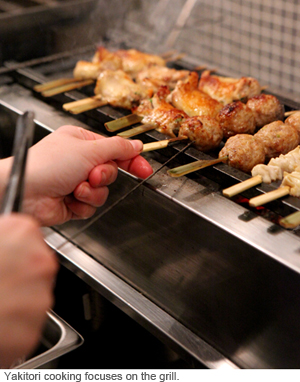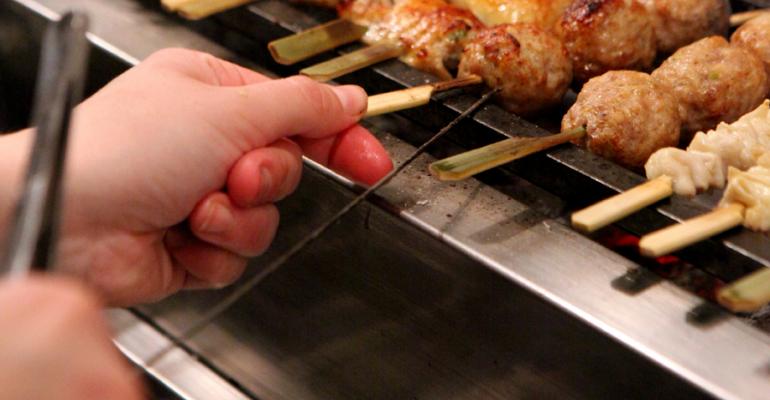After 14 years as Charlie Trotter’s right hand man, Matthias Merges started thinking about stepping out a couple of years back. Late last fall his daydreams came to life as he opened Yusho, a decidedly casual izakaya (drinks)/yakitori (grilled skewers)-style spot in Chicago’s Logan Square neighborhood. There, he presides over a tiny open kitchen to make sure the street food-inspired menu is executed the way he envisioned. The narrow, 90-seat spot has been packed. We recently spoke with Merges about his professional evolution and the future of fine dining.
RH: What’s the back story on Yusho?
Merges: My wife and family and I love to travel, and we tend to base our travels around food and exploring new cultures. We’ve always loved how there are a lot of great street cultures in world, and the food is always great. My wife, Rachel Crowl, has her own firm, and they do a lot of development work. So we decided to look at some great properties that had potential, and we reverse-engineered the concept into the space. We thought the idea of combining the hallmarks of Japanese yakitori—cooking proteins over open coals or flame—with street food ideas seemed like the right move. Our recipes have been inspired by things we’ve tasted and seen and experienced during multiple visits to Japan.
RH: You brought another Charlie Trotter’s veteran, Alex Bachman, on boardto steer the beverage program. How important is that side of the business?
Merges: We wanted to make sure that the hallmarks of the restaurant—the environment, cuisine, beverage and service—are all attended to with equal focus. So the cocktails, wine and sake programs all needed to be thoughtful and articulated well to stay in harmony with the rest of the vision. We didn’t want a typical beverage program. We wanted to do things differently. Because the focus on the food side is making things in-house, it’s the same with the drinks. We make our own bitters, tonics, draft cocktails and so on.
 RH: You also do a remarkable job of matching food with drinks. How do you accomplish that?
RH: You also do a remarkable job of matching food with drinks. How do you accomplish that?
Merges: It’s a combination of training and developing a list that works for pairings. So if you come in and order two or three items and tell us you want to try a beer, we need to be able to match our beer list with the food. Same with cocktails, wine and sake. We didn’t want to limit ourselves to doing only wine and being so formal.
There is such a formality about tasting menus with beverage pairings. We wanted to break away from that and make it more fun. Ultimately it’s up to the waitstaff to ask the right questions at the table and pick up on the dynamic. They know when people want a bowl of noodles and a beer.
RH: Your wife worked with you on the design. What kind of statement were you going for?
Merges: We got our inspiration from places like fish markets in Japan where the lights in the stalls are all different and they use single, clear bulbs with almost no shade. All the wood—bartops, booths, shelving—was reclaimed out of a machine shop in Madison, WI. Rachel loves to use industrial and tactile materials, so instead of putting traditional sound dampening in the rafters, we used industrial felt to dampen the machine noise. The restaurant is in two distinct rooms: The front is intimate, lower ceilings and a little tighter, so you get the feel of small places in Japan; the room in back has 20-foot ceilings and a different feel.
RH: How much of a transition was it from the formal atmosphere at Charlie Trotter’s to the laid-back vibe here?
Merges: I’ve been in fine dining practically forever. But I wanted to explore other areas of creativity. I decided the basic truths and philosophy involved in cooking food well and serving it with integrity and passion could be translated to make it more accessible.
I wanted to challenge myself to look at food and cuisine and cooking at a different angle—to keep myself sharp. It would have been easy to do the fine dining angle, and it was everyone’s expectation that I would do that.
It was a big transition in the sense that I had to look at things in a different light. There are things about fine dining that you take for granted that you can’t take for granted in a small space with an accessible menu. You need to be more creative. You cannot rely on the luxury products that can pull certain menus through. How can you use daikon or a potato or whatever the product may be and show it off in a way that’s exciting?
RH: Any specific examples on your menu?
Merges: One of the things we do here is skin tastings. We take pork, chicken and salmon skin and serve it as is. I would call it an elevated snack. We can’t keep it on the menu because of the volume.
RH: Now that you are running the show, how would you compare your management style to your former boss’s?
Merges: I think we both had our own way to run the kitchen there, but we really played off each other. I am demanding and I do try to push because I think people excel when pushed and they are looking for that from leaders. But I also realize there is a nurturing process when training cooks, servers and barkeeps, and you need to keep that in consideration.
RH: What do you think about the future of high-end dining?
Merges: I think there will always be a place for it, but it will become limited. There are a lot of great cooks and chefs out there who understand the value and the craft and are able to bring accessibility to the table. There is more accessible, really good food than there ever has been. People seek it out. They know more about food, wine, cocktails and so on, and their expectations are raised. Frankly, it’s a little more fun to offer those things to a larger audience.
0 comments
Hide comments





